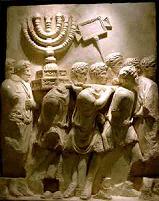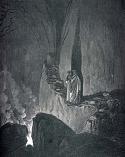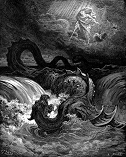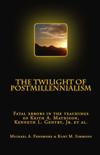Why Two Millennia?
By
Kurt Simmons
A caller recently asked about why we hold that Revelation twenty contemplates two millennia; we answer that question briefly here.
The Models of Other Writers Also Produce Two Millennia
Initially, it should be noted that we are not alone among Preterist authors in holding to a two (bi-) millennial model. The models set forth by King, and I believe Preston, Stevens , and others also produce two millennia. They operate on the assumption of a single millennium, but analysis of their models will show that, in fact, two come forth. King was the first to commit his model to writing and it has served as the model followed by others. So, let us begin by demonstrating that King’s system produces two millennia, before explaining our own.
The basic framework of King’s model has it that the millennium refers to the period from Christ’s ministry to the Jewish war with Rome. King equates the binding of the dragon in Rev. 20:1-3 with the binding of the strong man in Matt. 12:29. King appears to borrow this interpretation from Postmillennialism. In fact, his system essentially mirrors Postmillennialism, except that where Postmillennialism traditionally extends the “thousand years” into the indefinite future, King foreshortens it to accommodate Christ’s AD 70 return. According to King then, the beginning of the millennium is Christ’s ministry, which began in A.D. 30.[1] He next has it that the millennium ends approximately A.D. 67 when the war with Rome begins. In Rev. 20:7-10, the dragon is loosed for the battle of Gog and Magog, which King equates with the Jewish war with Rome. The millennial binding of the dragon therefore looks like this:
Thousand Year Binding of the Dragon
(Rev. 20:1-3 = Matt. 12:29)
AD 30_____________________________________AD 67
Ministry of Christ War with Rome
So much for the binding of the dragon; let us look at the reign of the saints. According to King, the millennial reign of the saints in Rev. 20:4-6 refers to the participation of the church in Christ’s resurrection by baptism. This begins on Pentecost A.D. 33 and ends at the resurrection in A.D. 70. I believe this is the position of Preston, Stevens, and many others. (If not, I welcome their correction.) Thus the millennial reign of the saints looks like this:
Thousand Year Reign of the Saints
(Rev. 20:4-6)
AD 33_______________________________________AD 70
Pentecost General Resurrection
A cursory look at these two timelines shows that they do not match. The one begins and ends earlier than the other. If they do not begin and end at the same time, it is obvious that they cannot represent the same events, and that a single millennium cannot embrace them both. The discrepancy noted in King’s system is inherent to the single millennial model. It results from the fact that two millennia are contemplated by the text, though men often confound them for one. This discrepancy was noted long ago by Augustine, the father of Postmillennialism:
“This last persecution by Antichrist will last for three years and six months, as we have already said, and as is stated both in the Apocalypse and by the prophet Daniel. Though this time is brief, it is rightly debated whether it belongs to the thousand years during which it is said that the devil is bound and the saints reign with Christ, or whether this short span is to be added to those years and is over and above them. For if we say that it belongs to the thousand years, then it will be found that the reign of the saints with Christ extends not for the same length of time as the binding of the devil, but for a longer time…How, then does Scripture include in the same limit of a thousand years both the binding of the devil and the reign of the saints, if the binding of the devil is to cease three years and six months before the reign of a thousand years of the saints with Christ?”[2]
The importance of this admission can hardly be overstated. Here we have the great Augustine, who is called the father of Postmillennialism, admitting that the single millennium model is inherently flawed and that reign of the saints cannot be brought within the thousand-year binding of the dragon! Although Augustine recognized the discrepancy inherent in the single millennium model, he did not see his way clear how to reconcile it. Returning now to King’s scheme, it is plain that two millennia are produced by his model. In fact, King all but admits there are two millennia when he states:
“The time of the scene in verse four of our text is after the Neronian [sic] persecution…It corresponds to the time when Satan was bound a thousand years. Satan is bound a thousand years and the saints lived and reigned with Christ a thousand years…These two one thousand year terms are like the North and South Poles.”[3]
There you have it. King actually articulated the fact of two millennia! “These two one thousand year terms” he said! Unfortunately, King did not grasp the full implications of what he said or the meaning of the text, and continued to operate on the mistaken assumption of a single millennium. If he had only stopped to put his dates down on paper, the fact that his system produces two millennia would have become immediately apparent. But, as it is, it was left for us to point this out.
Other Commentators
At his point, let us pause and notice that there have been others who noticed two millennia in the text before either King or myself (though King did not fully realize what he was seeing).
John Albert Bengel - A thousand years - Two millennial periods are mentioned in this whole passage… The confounding of the two millennial periods has long ago produced many errors, and has made the name of Chiliasm hateful and suspected.[4]
John Wesley - "A thousand years — It must be observed, that two distinct thousand years are mentioned throughout this whole passage. Each is mentioned thrice; the thousand wherein Satan is bound, verses 2, 3, 7; the thousand wherein the saints shall reign, verses 4-6. The former end before the end of the world; the latter reach to the general resurrection. So that the beginning and end of the former thousand is before the beginning and end of the latter. Therefore as in the second verse, at the first mention of the former; so in the fourth verse, at the first mention of the latter, it is only said, a thousand years; in the other places, "the thousand," verses 3, 5, 7, that is, the thousand mentioned before. During the former, the promises concerning the flourishing state of the church, shall be fulfilled; during the latter, while the saints reign with Christ in heaven, men on earth will be careless and secure."[5]
Others seeing two millennia include Daniel Steele and John Owen.[6] The idea of two millennia, therefore, does not originate with us, but boasts prominent scholars from earlier days.
Bimillennial Preterism
Having, I think, established the presence of two millennia in the text, let us briefly give our view of the matter. We hold that the binding of the dragon points to the period from the collapse of the persecution that arose over Stephen until the persecution under Nero. It is symbolic of the restraint upon the world civil power during much of the reign of Claudius when the Jews were prohibited to get up a persecution in Palestine, Asia, and the world. The dragon acts through the beast to make war against the saints and persecute the church. Both symbolically went down to the bottomless pit when the persecution over Stephen collapsed. This is portrayed by the wound to the beast’s head (Rev. 13:3, 14) and referred to in saying it was, is not, and was about to ascend out of the bottomless pit. (Rev. 17:8) That is, the persecuting power of the world civil power (the dragon) was symbolically slain in the collapse of the persecution, but was about to revive and persecute the church anew (viz., the wound to its head would heal). The beast is loosed when the dragon is loosed, for the beast acts only by the authority of the dragon. (Rev. 13:2) Both would ascend from the bottomless pit for the final eschatological battle under Nero (the battle of Gog and Magog/Armageddon).
The reign of the saints points to the victory of the martyrs and their reign in paradise with Christ pending the general resurrection. Their reign begins where the binding of the dragon ends. This is opposite of most commentators, who assume that the reign of the saints is defined by the binding of the dragon. But a close reading gives the lie to this scheme. The saints do not reign until they suffer martyrdom under the beast and dragon. Hence, it is not until the dragon and beast are loosed for the battle of Gog and Magog (Armageddon) that they suffer martyrdom and obtain the martyr’s crown. In Rev. 14:9-13, a blessing is pronounced upon those that are faithful unto death and martyrdom under the beast. “Blessed are the dead that die from henceforth.” Those referred to here are the same portrayed victorious in Rev. 20:4-6; the blessing pronounced in Rev. 14:13 is received by the martyrs in Rev. 20:4-6. What is that blessing? They are participants of the first resurrection; they live and reign with Christ in Hades Paradise pending the general resurrection. Technically, all the saints share in this reign. I do not believe that the martyrs received a special resurrection. The point of the passage seems to be to fortify their faith against the coming crisis by showing that they will receive a thorough reward from God.
The common symbol of a thousand years points to the fact both are in Hades – the dragon symbolically in Tartarus (the bottomless pit), the saints actually in Paradise. The point of the symbol is to show that both are among the dead, beyond the realm of earthly time and space. The binding of the dragon finds its parallel in II Pet. 2:4 where the “angels that sinned” were bound with chains in Tartarus until the judgment of the great day. Hence, Matt. 12:29 is not the source of the imagery. It is also Peter who tells that the realm of the spirit does not measure time as we don upon earth, and that one day is as a thousand years, and so forth. (II Pet. 3:8; cf. Ps. 90:4) Also, it is more than a little interesting that according to Greco-Roman notions of Hades, the dead inhabited Hades (Elysium for the good, Purgatory/Tartarus for the evil) for a thousand years before they returned to earthly life.[7] Revelation was addressed to the Greek and Roman speaking peoples of Asia Minor who would suffer martyrdom under Nero and the Jews. The symbol of a thousand years would likely have been easily recognized by them as a reference to their blessed state in Paradise, so they could bravely face death for the name of Christ.
[1] Christ was born in 2 B.C.; he was baptized in the 15th of Tiberius when he was not yet thirty, which translates to the fall of A.D. 29. (Lk. 3:1, 23)
[2] Augustine, The City of God, XX, xiii; Loeb ed.
[3] Max R. King, The Spirit of Prophecy (Warren OH, 1971), p.347.
[4] Jno. Bengel, Gnomon Novi Testamenti, in loc.
[5] John Wesley, Commentary on Revelation, in loc.
[6] Dandiel Steele, S.T.D., A Substitute for Holiness or, Antinomianism Revisited, Chapter XIV, Difficulties in the Thousand Years. http://www.gospeltruth.net/Antinomianism/antinom_toc.htm
[7] Virgil, Aeneid, Bk. VI, 734-769; C. Day Lewis ed (1952, Hogarth Press, London. Cf. Plato, Republic, Bk. X, 315-320; Ben. Jowett ed; Justin Martyr, confusing Virgil’s account with Plato’s, equates Purgatory with Tartarus. See Justin Martyr, 1st Apology, VIII, Ante-Nicene Fathers, p. 165, where he attributes Virgil’s description of Rhadamanthus punishing the wicked to Plato. For a fuller account, see our article “Revelation’s Millennia and Greco-Roman Notions of Hades.”
To receive Kurt Simmons’ e-mail newsletter, The Sword & The Plow, click the Subscribe link:
All rights reserved.






